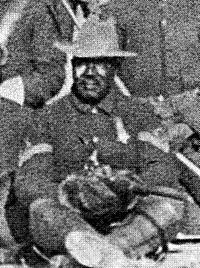George Jordan (Medal of Honor) facts for kids
Quick facts for kids
George Jordan
|
|
|---|---|

Sergeant George Jordan
|
|
| Born | 1847 Williamson County, Tennessee |
| Died | October 24, 1904 (aged 56–57) |
| Place of burial |
Fort McPherson National Cemetery, Maxwell, Nebraska
|
| Allegiance | United States |
| Service/ |
United States Army |
| Years of service | 1866–1897 |
| Rank | First Sergeant |
| Unit | 38th Infantry Regiment 9th Cavalry Regiment |
| Battles/wars | |
| Awards | Medal of Honor Certificate of Merit |
George Jordan (born 1847, died 1904) was a brave Buffalo Soldier in the United States Army. He received the Medal of Honor, which is America's highest award for military bravery. He earned this honor for his actions during the American Indian Wars in the western United States.
Contents
Early Life and Army Service
George Jordan was born in 1847 in Williamson County, Tennessee. After the American Civil War ended, he joined the United States Army from Nashville, Tennessee in 1866. He first served with the 38th Infantry Regiment.
Later, by 1880, he was a Sergeant in Company K of the 9th Cavalry Regiment. This unit was stationed in New Mexico.
Medal of Honor Actions
Jordan was awarded the Medal of Honor on May 7, 1890. This special award recognized his bravery in two different battles.
Battle of Fort Tularosa
His first brave action happened at the Battle of Fort Tularosa on May 14, 1880. During this battle, Sergeant Jordan showed great leadership and courage.
Battle of Carrizo Canyon
His second recognized action was at Battle of Carrizo Canyon on August 12, 1881. For his bravery here, he also received a Certificate of Merit. This certificate came with an extra $2 a month in pay, which was a good amount back then.
Later Career and Retirement
In 1887, Jordan was praised by his commander at Fort Robinson. This was for successfully capturing a prisoner who had escaped. He continued to serve with distinction.
George Jordan rose to the rank of First Sergeant, which is a very important leadership position for enlisted soldiers. He left the Army in 1897 after many years of service. After retiring, he lived in Crawford, Nebraska. He was part of a community there with other Buffalo Soldiers.
Jordan passed away in 1904. He was buried at Fort McPherson National Cemetery in Maxwell, Nebraska.

